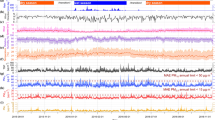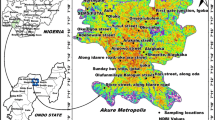Abstract
Particulate air pollution is associated with adverse health effects to the population exposed. The aim of this paper is the identification of local and regional sources, affecting PM10 and PM2.5 levels in four large cities of southern Europe, namely: Lisbon, Madrid, Marseille, and Rome. Air pollution data from seven sampling sites of the European Union network were used. These stations were selected due to their ability of monitoring PM2.5 concentrations and providing reliable series of data. Each station’s background was also taken into account. Pearson correlation coefficients and primal component analysis components were extracted separately for cold and warm periods in order to define the relationships among particle matters (PMs) and gaseous pollutants (CO, NO2, SO2, and O3) and evaluate the contributions of local sources. Possible seasonal variations of PM2.5/PM10 ratio daily values were also used as markers of PM sources, influencing particulate size distribution. Particle emissions were primarily attributed to traffic and secondarily to natural sources. Minimum daily values of PM2.5/PM10 ratio were observed during warm periods, particularly at suburban stations with rural background, due to dust resuspension and also due to the increase of biogenic coarse PM (pollen, dust, etc.). Hybrid Single-Particle Lagrangian Integrated Trajectory Model trajectory model was used in order to compute the 4-day backward trajectories of the air masses that affected the four cities which are under study during days with recorded PM10 exceedances, within a 5-year period (2003–2007), at 300, 750, and 1,500 m above ground level (AGL). The trajectories were then divided to clusters with a K-means analysis. In all four cities, the influence of slow-moving air masses was associated with a large fraction of PM10 exceedances and with high average and maximum daily mean PM10 concentrations, principally at the 300 m AGL analysis. As far the issue of the increased PM10 concentrations, the results were weaker in Marseille and particularly in Rome, probably due to their greater distance from Northwest Africa, in comparison to Madrid and Lisbon. Dust intrusions from the Sahara desert and transportation of Mediterranean/Atlantic sea spray, were characterized as primary regional sources of exogenous PM10 in all four cities. Continental trajectories from the industrialized northern Italy affected PM10 levels particularly in Marseille and Rome, due to their more eastern geographical position.




Similar content being viewed by others
References
Borge R, Lumbreras J, Vardoulakis S, Kassomenos P, Rodriguez E (2007) Analysis of long range transport influences on urban PM10 using two-stage atmospheric trajectory clusters. Atm Env 41:4434–4450
Chaloulakou A, Kassomenos P, Spyrellis N, Demokritou P, Koutrakis P (2003) Measurements of PM10 and PM2.5 particle concentrations in Athens. Greece Atm Env 37:649–660
Chen R, Chu C, Tan J, Cao J, Song W, Xu X, Jiang C, Ma W, Yang C, Chen B, Gui Y, Kan H (2010) Ambient air pollution and hospital admission in Shanghai. China J Haz Mat 181:234–240
Deacon AR, Derwent RG, Harrison RM, Middleton DR, Moorcroft S (1997) Analysis and interpretation of measurements of suspended particulate matter at urban background sites in the United Kingdom. Sci Tot Env 203:17–36
Dorling SR, Davies TD, Pierce CE (1992) Cluster analysis: a technique for estimating the synoptic meteorological controls on air and precipitation chemistry—method and applications. Atm Env 26:2575–2581
Dorling SR, Davies TD (1995) Extending cluster analysis-synoptic meteorology links to characterise chemical climates at six northwest European monitoring stations. Atm Env 29:145–167
Drobinski P, Said F, Ancellet G, Arteta J, Augustin P, Bastin P, Brut A, Vautard R (2007) Regional transport and dilution during high-pollution episodes in southern France: summary of findings from the Field Experiment to Constraint Models of Atmospheric Pollution and Emissions Transport (ESCOMPTE). J Geo Res D: Atm 112(13):D13105
El Haddad I, Marchand N, Wortham H, Piot C, Besombes JL, Cozic J, Chauvel C, Armengaud A, Robin D, Jaffrezo JL (2010) Primary sources of PM2.5 organic aerosol in an industrial Mediterranean city. Marseille Atm Chem Phys 10:25435–25490
Fleming ZL, Monks PS, Manning AJ (2012) Review: untangling the influence of air-mass history in interpreting observed atmospheric composition. Atm Res 104–105:1–39
Gehrig R, Buchmann B (2003) Characterising seasonal variations and spatial distribution of ambient PM10 and PM2.5 concentrations based on long-term Swiss monitoring data. Atm Env 37:2571–2580
Gerasopoulos E, Kouvarakis G, Babasakalis P, Vrekoussis M, Putaud JP Mihalopoulos N (2006) Origin and variability of particulate matter (PM10) mass concentrations over the Eastern Mediterranean. Atm Env 40:4679–4690
Gomes L, Mallet M, Roger JC, Dubuisson P (2008) Effects of the physical and optical prosperities of urban aerosols measured during the CAPITOUL summer campaign on the local direct radiative forcing. Meteorol Atmos Phys 102:289–306
Gupta AK, Patil RS, Gupta SK (2004) Influence of meteorological factors on air pollution concentration for a coastal region in India. Int J Env Poll 21:253–262
Jiménez E, Linares C, Rodríguez LF, Bleda MJ, Díaz J (2009) Short-term impact of particulate matter (PM2.5) on daily mortality among the over-75 age group in Madrid. Spain Sci Tot Env 407:5486–5492
Karaca F, Anil I, Alagha O (2009) Long-range potential source contributions of episodic aerosol events to PM10 profile of a megacity. Atm Env 43:5713–5722
Karaca F, Camci F (2010) Distant source contributions to PM10 profile evaluated by SOM based cluster analysis of air mass trajectory sets. Atm Env 44:892–899
Karakatsani A, Kapitsimadis F, Pipikou M, Chalbot MC, Kavouras IG, Orphanidou D, Papiris S, Katsouyanni K (2010) Ambient air pollution and respiratory health effects in mail carriers. Env Res 110:278–285
Katragkou E, Kazadzis S, Amiridis V, Papaioannou V, Karathanasis S, Melas D (2009) PM10 regional transport pathways in Thessaloniki, Greece. Atm Env 43:1079–1085, special issue
Linares C, Diaz J (2010) Short-term effect of concentrations of fine particulate matter on hospital admissions due to cardiovascular and respiratory causes among the over-75 age group in Madrid. Spain Pub Heal 124:28–36
Makra L, Matyasovszky I, Guba Z, Karatzas K, Anttila P (2011) Monitoring the long-range transport effects on urban PM10 levels using 3D clusters of backward trajectories. Atm Env 45:2630–2641
Markou M, Kassomenos P (2010) Cluster analysis of five years of back trajectories arriving in Athens. Greece Atm Res 98:438–457
Martins A, Cerqueira M, Ferreira F, Borrego C, Amorim JH (2005) Lisbon air quality—evaluating traffic hot-spots. Third International Symposium on Air Quality Management at Urban Regional and Global Scales, Instanbul-Turkey
McGregor GR (1993) A multivariate approach to the climatic region and climatic resources of China. Geoforum 24:357–380
Modey W, Eatough D, Anderson R, Martello D, Takahama S, Lucas L, Davidson C (2004) Ambient fine particulate concentrations and chemical composition at two sampling sites in metropolitan Pittsburgh: a 2001 intensive summer study. Atm Env 38:3165–3178
Oguz E, Kava MD, Nuhoglu Y (2003) Interaction between air pollution meteorological parameters in Erzurum. Turkey Int J Env Poll 19:292–300
Riccio A, Giunta G, Chianese E (2007) The application of a trajectory classification procedure to interpret air pollution measurements in the urban area of Naples. Sci Tot Env 376:198–214
Saliba, Jam F, Tayar G, Obeid W, Roumie M (2010) Origin and variability of particulate matter (PM10 and PM2.5) mass concentrations over an Eastern Mediterranean city. Atm Res 97:106–114
Salvador P, Artinano B, Pio C, Afonso J, Legrand M, Puxbaum H, Hammer S (2010) Evaluation of aerosol sources at European high altitude background sites with trajectory statistical methods. Atm Env 44:2316–2329
Sawant A, Na K, Zhu X, Cocker D (2004) Chemical characterization of outdoor PM2.5 and gas-phase compounds in Mira Loma. California Atm Env 38:5517–5528
Srimuruganandam B, Nagendra SM (2011) Characteristics of particulate matter and heterogeneous traffic in the urban area of India. Atm Env 45:3091–3102
Szyszkowicz M, Rowe B (2010) Air pollution and emergency department visits for chest pain and weakness in Edmonton, Canada. Int J Occup Med Env Heal 23:15–19
Udisti R, Dayan U, Becagli S, Busetto M, Frosini D, Legrand M, Lucarelli F, Preunkert S, Severi M, Traversi R, Vitale V (2012) Sea spray aerosol in central Antarctica. Present atmospheric behaviour and implications for paleoclimatic reconstructions. Atm Env 52:109–120
Vardoulakis S, Kassomenos P (2008) Sources and factors affecting PM10 levels in two European cities: implications for local air quality management. Atm Env 42:3949–3963
Wang F, Chen DS, Cheng SY, Li JB, Li MJ, Ren ZH (2010) Identification of regional atmospheric PM10 transport pathways using HYSPLIT, MM5-CMAQ and synoptic pressure pattern analysis. Env Mod Soft 25:927–934
Yoo HJ, Kim J, Muk Yi S, Duk Zoh K (2011) Analysis of black carbon, particulate matter, and gaseous pollutants in an industrial area in Korea. Atm Env 45:7698–7704
Acknowledgments
The authors would like to thank the European Union Air Quality Database (Airbase) for the provision of the air pollution data necessary for this study. We would also like to recognize the contribution of the NOAA Air Resources Laboratory for providing the HYSPLIT trajectory model.
Author information
Authors and Affiliations
Corresponding author
Rights and permissions
About this article
Cite this article
Dimitriou, K., Kassomenos, P. The fine and coarse particulate matter at four major Mediterranean cities: local and regional sources. Theor Appl Climatol 114, 375–391 (2013). https://doi.org/10.1007/s00704-013-0851-y
Received:
Accepted:
Published:
Issue Date:
DOI: https://doi.org/10.1007/s00704-013-0851-y




